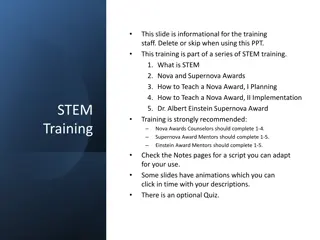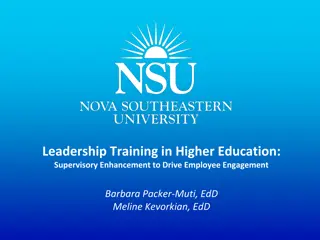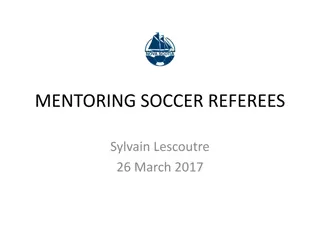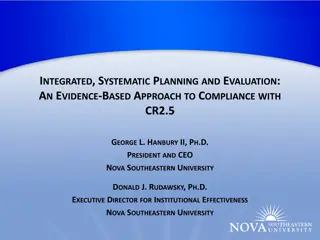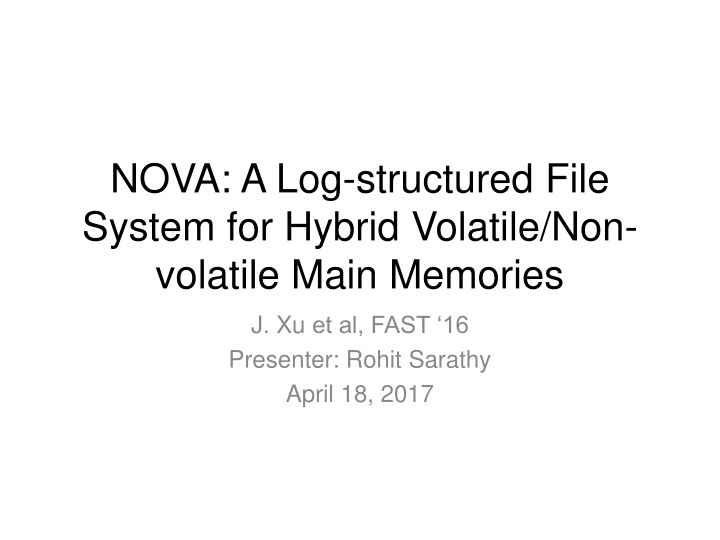
Log-Structured File System for Hybrid Volatile/Non-volatile Memories
Learn about NOVA, a log-structured file system designed for hybrid volatile/non-volatile memories. Explore its contributions, design aspects, data structures, challenges, and comparisons with other NVMMs.
Download Presentation

Please find below an Image/Link to download the presentation.
The content on the website is provided AS IS for your information and personal use only. It may not be sold, licensed, or shared on other websites without obtaining consent from the author. If you encounter any issues during the download, it is possible that the publisher has removed the file from their server.
You are allowed to download the files provided on this website for personal or commercial use, subject to the condition that they are used lawfully. All files are the property of their respective owners.
The content on the website is provided AS IS for your information and personal use only. It may not be sold, licensed, or shared on other websites without obtaining consent from the author.
E N D
Presentation Transcript
NOVA: A Log-structured File System for Hybrid Volatile/Non- volatile Main Memories J. Xu et al, FAST 16 Presenter: Rohit Sarathy April 18, 2017
NVMM Challenges Performance Write reordering Atomicity 2
NOVAs contributions Extends existing log-structured file system techniques Atomic-mmap Adaptable across many NVMM systems 3
Why LFS? Log-structuring provides cheaper atomicity than journaling and shadow paging NVMM supports fast, highly concurrent random accesses 4
NOVA Design Maintain logs in NVMM and indexes in DRAM Each inode has its own log Utilize logging and lightweight journaling for complex atomic updates Implement the log as a singly linked list No logging of file data 6
NVMM Data Structures Divides the NVMM into 4 parts (superblock and recovery inode, inode tables, journals, log/data pages Figure 1: NOVA data structure layout 7
Inode Table 2 MB block array of inodes Aligned on 128-byte boundary If inode table is full, build a linked list of 2 MB subtables Inode contains valid bit, NOVA reuses invalid nodes for new files and directories Log is linked list of 4KB pages Each inode has pointers to head and tail of its corresponding log 8
Journal 4KB circular buffer Managed with an <enqueue, dequeue> ptr pair Only one open transaction allowed per core Kernel VFS locks all affected inodes to protect concurrent transactions 9
Space Management NOVA divides NVMM into pools (one per CPU) If no pages free, allocate from largest pool Use a red-black tree to maintain free list sorted by address Allocator state not stored in NVMM Allocates log space aggressively to avoid resizes If full, allocate new pages for double the log space 10
Atomicity and write ordering 64-bit atomic updates Logging Lightweight journaling Enforce write ordering Commit data and log entries to NVMM Commit journal entries to NVMM Commit new versions of data pages to NVMM new_tail = append_to_log(inode->tail, entry); // writes back the log entry cachelines clwb(inode->tail, entry->length); sfence(); // orders subsequent PCOMMIT PCOMMIT(); // commits entry to NVMM sfence(); // orders subsequent store inode->tail = new_tail; Pseudocode for enforcing write ordering. If NOVA runs on a system that supports clfushopt(), clwb() and PCOMMIT operations, it will use the above code. 11
Directory Operations Closely linked to application performance NOVA directories = NVMM inode log + DRAM radix tree Log has two entries: dentry and inode update entries Use dentry timestamp to atomically update directory inode s mtime and ctime 12
Directory Operations Create 1. Append dentry to directory log 2. Update log tail (transaction) 3. Update radix tree Delete (NOVA) 1. Append delete dentry log entry to directory 2. Append inode update entry 3. Use journaling to atomically update both log tails 4. Propagate changes in DRAM radix tree Delete (Linux) 1. Decrement link count of file inode 2. Remove file from directory 13
Atomic File Operations Inode log records metadata changes Radix tree in DRAM to locate file data by file offset Large writes are broken into multiple write requests, all appended in single update Reads: update access time with atomic write, and copy data to user buffer 14
Atomic File Operations 8 KB (2-page) write 1. write copy of data to new pages 2. Append file write entry 3. Update log tail 4. Update radix tree 5. Return old version of data to allocator 15
Atomic mmap Use NVMM to allocate replica pages Copy file to replica pages, and map replicas to address space Copy-on-write for file data, reclaim stale pages immediately Higher overhead, but stronger consistency guarantee Atomic mmap in DRAM? 16
Garbage Collection Collect stale pages during write ops Log entry is dead if it is not the last entry in the log OR File write entry is dead if it does not refer to valid data pages An inode update is dead if modifies the same piece of metadata Dentry update is dead if marked invalid 17
Fast GC vs. Thorough GC Fast GC No copying required Reclaim invalid log pages by deleting them from linked list Thorough GC If live entries account for < 50% of log space, applied after fast GC Copy live entries into new, compacted version of log Update DRAM data structure pointer Replace old w/new, reclaim old log NOVA log cleaning: (a) Fast GC (b) Thorough GC 18
Shutdown and Recovery Lazy rebuild : postpone rebuilding radix tree and inode until first system access Clean dismount Store NVMM page allocator state in recovery inode log No inode logs scanned = fast recovery (50 GB in 1.2 ms) 19
Shutdown and Recovery Unclean dismount Rebuild NVMM allocator info by scanning inode logs Check each journal, rollback uncommitted transitions Recovery thread on each CPU, scan inode tables in parallel Build bitmap of occupied pages, use result to rebuild allocator 20
Experimental setup NVMM Read Latency 100 ns 300 ns Write bandwidth Full DRAM 1/8 DRAM Clwb latency PCOMMIT latency 200 ns 500 ns STT-RAM PCM 40 ns 40 ns Workload Avg file size I/O size (r/w) Threads R/W ratio # of files Sm / lg Fileserver 128 KB 16 KB / 16 KB 50 1:2 100K / 400K Webproxy 32 KB 1 MB / 16 KB 50 5:1 100K / 1M Webserver 64 KB 1 MB / 8 KB 50 10:1 100K / 500K Varmail 32 KB 1 MB / 16 KB 50 1:1 100K / 1M 21
Filesystem Latencies NOVA provides lowest latency for each operation NOVA outperforms other filesystems between 35% to 17x NOVA only accounts for 21-28% of total latency in create and append ops NOVA delete latency increases by 76% 22
Filebench Throughput Figure 7: Filebench throughput with different filesystem patterns and dataset sizes on STT-RAM and PCM. 23
Full Filesystem Perfomance Duration NILFS2 F2FS NOVA GC pages Fast Thorough 10s FAIL 37,979 222,337 30s FAIL 23,193 222,229 120s FAIL 18,240 220,158 600s FAIL FAIL 209,454 3600s FAIL FAIL 205,347 0 102 255 2,120 17,385 9,633 159,406 27,292 1,170,611 72,727 30 GB fileserver workload under 95% NVMM utilization with different durations. 24
Recovery Dataset Videoserver Fileserver Mailserver Filesize 128 MB 1 MB 128 KB # of files 400 50,000 400,000 Dataset size 50 GB 50 GB 50 GB I/O size 1 MB 64 KB 16 KB Dataset STTRAM-normal PCM-normal STTRAM-failure PCM-failure Videoserver 156 s 311 s 37 ms 43 ms Fileserver 313 s 660 s 39 ms 50 ms Mailserver 918 s 1197 s 72 ms 116 ms 25
Conclusion An extension of LFS to leverage NVMM Fast GC, recovery from system failures Provides stronger consistency and atomicity guarantees 26
References J. Xu, S. Swanson. NOVA: A Log-structured File System for Hybrid Volatile/Non-volatile Main Memories. FAST 16 https://www.usenix.org/sites/default/files/conference/protected- files/fast16_slides_xu.pdf. ONLINE Accessed 2017-04-12. https://github.com/NVSL/NOVA. ONLINE Accessed 2017-04-12. 27






